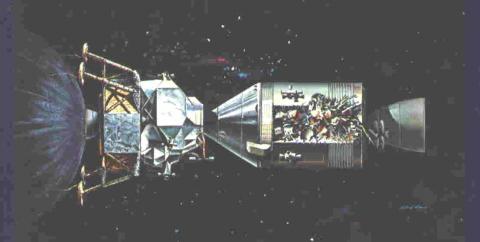-
Table of Contents
- 0. STORY PREFACE
- 1. WILBUR AND ORVILLE WRIGHT
- 2. AIRCRAFT CONTROL
- 3. LIFT AND DRAG
- 4. KITTY HAWK
- 5. THE FIRST FLIGHT
- 6. FLYER 3 and OTHER FAMOUS FLIGHTS
- 7. THE FIRST ROCKETS
- 8. EXPERIMENTAL PLANES
- 9. THE SOUND BARRIER
- 10. THE SPACE RACE
- 11. THE FIRST MAN & WOMAN IN SPACE
- 12. ALAN SHEPARD'S FLIGHT
- 13. JOHN GLENN'S ORBIT
- 14. DEATH IN THE COMMAND MODULE
- 15. TO THE MOON
- 16. APOLLO 11
- 17. APOLLO 13
- 18. THE SHUTTLE'S DESIGN FLAW
The accident which occurred during Apollo 13's intended trip to the Moon took place in the spacecraft's "Service Module." When an oxygen tank exploded, the event nearly resulted in a fatal mission. Image from a NASA document entitled Apollo 13 "Houston, we've got a problem." Online, courtesy NASA. Click on the image for a better view.
Everything seemed normal as Apollo 13 made its way through space following launch on April 11, 1970. Some people said the number "13" should never have been used in the first place. Other individuals (who make decisions about such things) weren't bothered by unscientific superstitions. They used the in-sequence mission number.
Jim Lovell, commander of the mission, was looking forward to his time on the moon. (The link is NASA's exploration plan for Apollo 13.) So was Fred Haise. On the other hand, Ken Mattingly (originally slated as the third member of the crew) was still home in Houston. He'd been exposed to German measles and, seventy-two hours before launch, was replaced by Jack Swigert.
Turns out, it was a good thing Mattingly was still on the ground. His expert help would soon be needed by his crew mates. (This link takes you to the official portrait of the crew which includes Mattingly in the middle.)
Nearly fifty-six hours into the flight - at about 10:06 PM EST, on the 13th of April, 1970 - Apollo 13 was in serious trouble. (This link takes you to the official Report of the Apollo 13 Review Board, in PDF format.) A short in the current from fuel-cell three had disrupted the cryogenic oxygen tank power supply. Two other shorts occurred a few seconds later.
Not only was the mission in trouble, the lives of the crew were in danger. The severely damaged Service Module had lost its ability to produce oxygen and water. Swigert, followed by Lovell, radioed mission control:
Mission Control in Houston, together with Ken Mattingly, feverishly worked out a way to get the crew back to earth. It wasn't easy. The solution was complicated.
Meanwhile, with their oxygen being depleted, the crew in space had to power-down their Command Module ("Odyssey"), power-up the Lunar Module ("Aquarius"), and make sure they had working airlines. The tiny LM would not take them to the moon this trip, but it would help to save their lives.

Creating a solution on the ground, flight controllers needed to develop a mission-saving system which could be duplicated in space. Simple items, such as cardboard and tape, were used to a create a "mail box" that saved the astronauts.
One hour before reentry, the crew jettisoned Aquarius. Their "life boat" would not survive a reentry.
Apollo 13 landed in the Pacific Ocean 142 hours, 54 minutes and 41 seconds after lift-off. The USS Iwo Jima recovered the men and Odyssey. Nearly two-thirds of the mission had been under extreme emergency conditions. (These links include historical footage of the launch, the problem and the recovery.)
NASA's Houston team - and the flight crew members (all of whom are still alive except for Swigert who died of cancer in 1982) - had turned in a brilliant performance. Calm thinking by Johnson Space Center personnel, working under extraordinary pressure, helped to save the mission. Of their collective efforts, Jim Lovell later said:
I think one of the things that showed the people of the world was that even if there is a great catastrophe, good leadership and teamwork, initiative and perseverance - these things make for getting an almost certain catastrophe into a successful recovery.
Returning the crew safely was one of NASA's finest moments. Sixteen years later, horrible misjudgments and a lack of effective teamwork caused one of its greatest disasters.
-
Table of Contents
- 0. STORY PREFACE
- 1. WILBUR AND ORVILLE WRIGHT
- 2. AIRCRAFT CONTROL
- 3. LIFT AND DRAG
- 4. KITTY HAWK
- 5. THE FIRST FLIGHT
- 6. FLYER 3 and OTHER FAMOUS FLIGHTS
- 7. THE FIRST ROCKETS
- 8. EXPERIMENTAL PLANES
- 9. THE SOUND BARRIER
- 10. THE SPACE RACE
- 11. THE FIRST MAN & WOMAN IN SPACE
- 12. ALAN SHEPARD'S FLIGHT
- 13. JOHN GLENN'S ORBIT
- 14. DEATH IN THE COMMAND MODULE
- 15. TO THE MOON
- 16. APOLLO 11
- 17. APOLLO 13
- 18. THE SHUTTLE'S DESIGN FLAW


 Back
Back
 Next Chapter
Next Chapter

 Back
Back
 Next Chapter
Next Chapter



